Predicting Urban Expansion to Assess the Change of Landscape Character Types and Its Driving Factors in the Mountain City
Abstract
1. Introduction
2. Study Area and Data
2.1. Study Area
2.2. Data and Pre-Precession
3. Methodology
3.1. Prediction of Land-Use Change
3.1.1. Plus Model
3.1.2. Driving Factors Selection
3.1.3. Model Parameter Setting
3.2. Index Systems to Cluster Landscape Character Types
3.3. Cluster of Landscape Character Types
4. Results
4.1. Prediction of Land-Use Changes
4.2. Cluster of Landscape Character Types
4.3. Spatial Distribution and Changes of Landscape Character Types
4.4. Contribution of the Driving Factors to Landscape Character Types Change
5. Discussion
5.1. Advantages of Landscape Character Types for Landscape Management
5.2. Relationships between Land-Use and Changes in Landscape Character Types
5.3. Influence of the Critical Driving Factors
6. Conclusions
- (1)
- If the urban development trend from 2000 to 2020 continues until 2040, urban construction land in the central city of Chongqing will encroach on a large amount of farmland (79.6%) and a small amount of forest (10.1%). There has also been some expansion of urban construction land around some rivers and forests.
- (2)
- From 2000 to 2040, there is an encroachment of the LCTs (dominated by farmland) around the built-up area by another LCT (dominated by urban construction land), as well as an expansion of villages away from the built-up area.
- (3)
- The driving factors contribute to the conversion of all land-use types, from high to low: the nighttime light, POI, elevation, and distance to trunk roads. The distance to water bodies mainly influences the conversion of water bodies and urban construction land. Population density and distance to trunk roads mainly influence the conversion of rural construction land.
- (4)
- There are also differences in the main driving factors affecting changes in LCTs. The nighttime light has the highest contribution to Types 1, 4, 5, 7, and 8. The elevation has the highest contribution to Types 3 and 6.
Author Contributions
Funding
Data Availability Statement
Conflicts of Interest
References
- Grimm, N.B.; Faeth, S.H.; Golubiewski, N.E.; Redman, C.L.; Wu, J.; Bai, X.; Briggs, J.M. Global change and the ecology of cities. Science 2008, 319, 756–760. [Google Scholar] [CrossRef]
- Dolejš, M.; Nádvorník, J.; Raška, P.; Riezner, J. Frozen Histories or Narratives of Change? Contextualizing Land-Use Dynamics for Conservation of Historical Rural Landscapes. Environ. Manag. 2019, 63, 352–365. [Google Scholar] [CrossRef] [PubMed]
- United Nations Population Division. The World at Six Billion; United Nations Secretariat: Washington, DC, USA, 2000; Volume 26, p. 841. [Google Scholar]
- Cao, Y.; Bai, Z.; Zhou, W.; Ai, G. Gradient Analysis of Urban Construction Land Expansion in the Chongqing Urban Area of China. J. Urban Plan. Dev. 2015, 141, 05014009. [Google Scholar] [CrossRef]
- Xie, Y.; Fang, C.; Lin, G.C.S.; Gong, H.; Qiao, B. Tempo-spatial patterns of land use changes and urban development in globalizing China: A study of Beijing. Sensors 2007, 7, 2881–2906. [Google Scholar] [CrossRef]
- Gong, J.; Yang, J.; Tang, W. Spatially Explicit Landscape-Level Ecological Risks Induced by Land Use and Land Cover Change in a National Ecologically Representative Region in China. Int. J. Environ. Res. Public Health 2015, 12, 14192–14215. [Google Scholar] [CrossRef] [PubMed]
- Jin, X.; Jin, Y.; Mao, X. Ecological risk assessment of cities on the Tibetan Plateau based on land use/land cover changes—Case study of Delingha City. Ecol. Indic. 2019, 101, 185–191. [Google Scholar] [CrossRef]
- Sala, O.E.; Chapin, F.R.; Armesto, J.J.; Berlow, E.; Bloomfield, J.; Dirzo, R.; Huber-Sanwald, E.; Huenneke, L.F.; Jackson, R.B.; Kinzig, A.; et al. Global biodiversity scenarios for the year 2100. Science 2000, 287, 1770–1774. [Google Scholar] [CrossRef]
- Xie, H.; Wang, P.; Huang, H. Ecological risk assessment of land use change in the Poyang Lake Eco-economic Zone, China. Int. J. Environ. Res. Public Health 2013, 10, 328–346. [Google Scholar] [CrossRef]
- She, Y.; Shen, L.; Jiao, L.; Zuo, J.; Tam, V.W.Y.; Yan, H. Constraints to achieve infrastructure sustainability for mountainous townships in China. Habitat Int. 2018, 73, 65–78. [Google Scholar] [CrossRef]
- Karpouzoglou, T.; Dewulf, A.; Perez, K.; Gurung, P.; Regmi, S.; Isaeva, A.; Foggin, M.; Bastiaensen, J.; Van Hecken, G.; Zulkafli, Z.; et al. From present to future development pathways in fragile mountain landscapes. Environ. Sci. Policy 2020, 114, 606–613. [Google Scholar] [CrossRef]
- Lin, X.; Wang, Z. Landscape ecological risk assessment and its driving factors of multi-mountainous city. Ecol. Indic. 2023, 146, 109823. [Google Scholar] [CrossRef]
- Yao, F.; Hao, C.; Zhang, J. Simulating urban growth processes by integrating cellular automata model and artificial optimization in Binhai New Area of Tianjin, China. Geocarto Int. 2016, 31, 612–627. [Google Scholar] [CrossRef]
- Molinero-Parejo, R.; Aguilera-Benavente, F.; Gómez-Delgado, M.; Shurupov, N. Combining a land parcel cellular automata (LP-CA) model with participatory approaches in the simulation of disruptive future scenarios of urban land use change. Comput. Environ. Urban Syst. 2023, 99, 101895. [Google Scholar] [CrossRef]
- Zhang, Y.; Chang, X.; Liu, Y.F.; Lu, Y.C.; Wang, Y.H.; Liu, Y.L. Urban expansion simulation under constraint of multiple ecosystem services (MESs) based on cellular automata (CA)-Markov model: Scenario analysis and policy implications. Land Use Policy 2021, 108, 105667. [Google Scholar] [CrossRef]
- Okwuashi, O.; Ndehedehe, C.E. Integrating machine learning with Markov chain and cellular automata models for modelling urban land use change. Remote Sens. Appl. Soc. Environ. 2021, 21, 100461. [Google Scholar] [CrossRef]
- Lemonsu, A.; Viguié, V.; Daniel, M.; Masson, V. Vulnerability to heat waves: Impact of urban expansion scenarios on urban heat island and heat stress in Paris (France). Urban Clim. 2015, 14, 586–605. [Google Scholar] [CrossRef]
- Rifat, S.A.A.; Liu, W. Predicting future urban growth scenarios and potential urban flood exposure using Artificial Neural Network-Markov Chain model in Miami Metropolitan Area. Land Use Policy 2022, 114, 105994. [Google Scholar] [CrossRef]
- Wu, J. Landscape sustainability science (II): Core questions and key approaches. Landsc. Ecol. 2021, 36, 2453–2485. [Google Scholar] [CrossRef]
- Turetta, A.P.D.; Prado, R.B.; Valladares, G.D.S. Evaluating the Potential of Landscape Metrics in Supporting Landscape Planning in Atlantic Forest: Rio de Janeiro, Brazil. Int. J. Agric. Environ. 2013, 4, 55–67. [Google Scholar] [CrossRef]
- Karasov, O.; Külvik, M.; Burdun, I. Deconstructing landscape pattern: Applications of remote sensing to physiognomic landscape mapping. Geojournal 2021, 86, 529–555. [Google Scholar] [CrossRef]
- Kim, K.; Pauleit, S. Landscape character, biodiversity and land use planning: The case of Kwangju City Region, South Korea. Land Use Policy 2007, 24, 264–274. [Google Scholar] [CrossRef]
- Swanwick, C. Society’s attitudes to and preferences for land and landscape. Land Use Policy 2009, 26, S62–S75. [Google Scholar] [CrossRef]
- Liu, W.; Yu, Z. Identification and assessment of landscape character of Haidian District, Beijing. Chin. J. Ecol. 2016, 35, 1338–1344. [Google Scholar] [CrossRef]
- Ode, Å.; Tveit, M.S.; Fry, G. Capturing Landscape Visual Character Using Indicators: Touching Base with Landscape Aesthetic Theory. Landsc. Res. 2008, 33, 89–117. [Google Scholar] [CrossRef]
- Meng, Y.; Xing, H. Exploring the relationship between landscape characteristics and urban vibrancy: A case study using morphology and review data. Cities 2019, 95, 102389. [Google Scholar] [CrossRef]
- Bartlett, D.; Gomez-Martin, E.; Milliken, S.; Parmer, D. Introducing landscape character assessment and the ecosystem service approach to India: A case study. Landsc. Urban Plan. 2017, 167, 257–266. [Google Scholar] [CrossRef]
- Medeiros, A.; Fernandes, C.; Gonçalves, J.F.; Farinha-Marques, P. A diagnostic framework for assessing land-use change impacts on landscape pattern and character—A case-study from the Douro region, Portugal. Landsc. Urban Plan. 2022, 228, 104580. [Google Scholar] [CrossRef]
- Liu, X.; Ming, Y.; Liu, Y.; Yue, W.; Han, G. Influences of landform and urban form factors on urban heat island: Comparative case study between Chengdu and Chongqing. Sci. Total Environ. 2022, 820, 153395. [Google Scholar] [CrossRef] [PubMed]
- Xiang, S.; Wang, Y.; Deng, H.; Yang, C.; Wang, Z.; Gao, M. Response and multi-scenario prediction of carbon storage to land use/cover change in the main urban area of Chongqing, China. Ecol. Indic. 2022, 142, 109205. [Google Scholar] [CrossRef]
- Li, W.; Wang, Y.; Xie, S.; Cheng, X. Coupling coordination analysis and spatiotemporal heterogeneity between urbanization and ecosystem health in Chongqing municipality, China. Sci. Total Environ. 2021, 791, 148311. [Google Scholar] [CrossRef]
- Zhang, Q.; Chen, C.; Wang, J.; Yang, D.; Zhang, Y.; Wang, Z.; Gao, M. The spatial granularity effect, changing landscape patterns, and suitable landscape metrics in the Three Gorges Reservoir Area, 1995–2015. Ecol. Indic. 2020, 114, 106259. [Google Scholar] [CrossRef]
- Chen, J.; Gao, M.; Cheng, S.; Hou, W.; Song, M.; Liu, X.; Liu, Y. Global 1 km × 1 km gridded revised real gross domestic product and electricity consumption during 1992–2019 based on calibrated nighttime light data. Sci. Data 2022, 9, 202. [Google Scholar] [CrossRef]
- Gao, L.; Tao, F.; Liu, R.; Wang, Z.; Leng, H.; Zhou, T. Multi-scenario simulation and ecological risk analysis of land use based on the PLUS model: A case study of Nanjing. Sustain. Cities Soc. 2022, 85, 104055. [Google Scholar] [CrossRef]
- Li, X.; Fu, J.; Jiang, D.; Lin, G.; Cao, C. Land use optimization in Ningbo City with a coupled GA and PLUS model. J. Clean. Prod. 2022, 375, 134004. [Google Scholar] [CrossRef]
- Liang, X.; Guan, Q.; Clarke, K.C.; Liu, S.; Wang, B.; Yao, Y. Understanding the drivers of sustainable land expansion using a patch-generating land use simulation (PLUS) model: A case study in Wuhan, China. Comput. Environ. Urban Syst. 2021, 85, 101569. [Google Scholar] [CrossRef]
- Zhang, X.; Jie, X.; Ning, S.; Wang, K.; Li, X. Coupling and coordinated development of urban land use economic efficiency and green manufacturing systems in the Chengdu-Chongqing Economic Circle. Sustain. Cities Soc. 2022, 85, 104012. [Google Scholar] [CrossRef]
- Lu, D.; Wang, Y.; Yang, Q.; Wang, Z.; Lin, A.; Tang, Y.; Li, Y. Effects of population spatial redistribution on vegetation greenness: A case study of Chongqing, China. Ecol. Indic. 2022, 138, 108803. [Google Scholar] [CrossRef]
- Nyanga, A.; Kessler, A.; Tenge, A. Key socio-economic factors influencing sustainable land management investments in the West Usambara Highlands, Tanzania. Land Use Policy 2016, 51, 260–266. [Google Scholar] [CrossRef]
- Kikuchi, H.; Emberger, G.; Ishida, H.; Fukuda, A.; Kobayakawa, S. Dynamic simulations of compact city development to counter future population decline. Cities 2022, 127, 103753. [Google Scholar] [CrossRef]
- Giles-Corti, B.; Saghapour, T.; Turrell, G.; Gunn, L.; Both, A.; Lowe, M.; Rozek, J.; Roberts, R.; Hooper, P.; Butt, A.; et al. Spatial and socioeconomic inequities in liveability in Australia’s 21 largest cities: Does city size matter? Health Place 2022, 78, 102899. [Google Scholar] [CrossRef] [PubMed]
- Wang, J.; Wu, K.; Du, Y. Does air pollution affect urban housing prices? Evidence from 285 Chinese prefecture-level cities. J. Clean. Prod. 2022, 370, 133480. [Google Scholar] [CrossRef]
- Garriga, C.; Hedlund, A.; Tang, Y.; Wang, P. Rural-urban migration and house prices in China. Reg. Sci. Urban Econ. 2021, 91, 103613. [Google Scholar] [CrossRef]
- Liu, G.; Wang, X.; Gu, J.; Liu, Y.; Zhou, T. Temporal and spatial effects of a ‘Shan Shui’ landscape on housing price: A case study of Chongqing, China. Habitat Int. 2019, 94, 102068. [Google Scholar] [CrossRef]
- Kasraian, D.; Li, L.; Raghav, S.; Shalaby, A.; Miller, E.J. Regional transport accessibility and residential property values: The case study of the Greater Toronto and Hamilton area. Case Stud. Transp. Policy 2023, 11, 100932. [Google Scholar] [CrossRef]
- Freiria, S.; Sousa, N.; Calvo-Poyo, F. Spatial analysis of the impact of transport accessibility on regional performance: A study for Europe. J. Transp. Geogr. 2022, 102, 103371. [Google Scholar] [CrossRef]
- Winkler, K.; Fuchs, R.; Rounsevell, M.; Herold, M. Global land use changes are four times greater than previously estimated. Nat. Commun. 2021, 12, 2501. [Google Scholar] [CrossRef]
- Cassin, J. Chapter 9—Nature-based solutions for source water protection in North America. In Nature-Based Solutions and Water Security; Cassin, J., Matthews, J.H., Gunn, E.L., Eds.; Elsevier: Amsterdam, The Netherlands, 2021; pp. 179–214. [Google Scholar]
- Wu, C.; Chen, B.; Huang, X.; Dennis Wei, Y.H. Effect of land-use change and optimization on the ecosystem service values of Jiangsu province, China. Ecol. Indic. 2020, 117, 106507. [Google Scholar] [CrossRef]
- Rudge, M.L.M.; Levick, S.R.; Bartolo, R.E.; Erskine, P.D. Developing landscape-scale forest restoration targets that embrace spatial pattern. Landsc. Ecol. 2022, 37, 1747–1760. [Google Scholar] [CrossRef]
- Fry, G.; Tveit, M.S.; Ode, Å.; Velarde, M.D. The ecology of visual landscapes: Exploring the conceptual common ground of visual and ecological landscape indicators. Ecol. Indic. 2009, 9, 933–947. [Google Scholar] [CrossRef]
- Atik, M.; Işıklı, R.C.; Ortaçeşme, V. Clusters of landscape characters as a way of communication in characterisation: A study from side, Turkey. J. Environ. Manag. 2016, 182, 385–396. [Google Scholar] [CrossRef]
- Gormus, S.; Oğuz, D.; Eşbah TuNÇAY, H.; Cengiz, S. Using Landscape Character Analysis to Assess The Relationship Between Protected and Nonprotected Areas: The Case of The Küre Mountains National Park. Tarım Bilim. Derg. 2021, 27, 414–425. [Google Scholar] [CrossRef]
- Lu, Y.; Xu, S.; Liu, S.; Wu, J. An approach to urban landscape character assessment: Linking urban big data and machine learning. Sustain. Cities Soc. 2022, 83, 103983. [Google Scholar] [CrossRef]
- Chuman, T.; Romportl, D. Multivariate classification analysis of cultural landscapes: An example from the Czech Republic. Landsc. Urban Plan. 2010, 98, 200–209. [Google Scholar] [CrossRef]
- Estoque, R.C.; Murayama, Y. Examining the potential impact of land use/cover changes on the ecosystem services of Baguio city, the Philippines: A scenario-based analysis. Appl. Geogr. 2012, 35, 316–326. [Google Scholar] [CrossRef]
- Acheampong, M.; Yu, Q.; Enomah, L.D.; Anchang, J.; Eduful, M. Land use/cover change in Ghana’s oil city: Assessing the impact of neoliberal economic policies and implications for sustainable development goal number one—A remote sensing and GIS approach. Land Use Policy 2018, 73, 373–384. [Google Scholar] [CrossRef]
- Yang, D.; Zhang, P.; Jiang, L.; Zhang, Y.; Liu, Z.; Rong, T. Spatial change and scale dependence of built-up land expansion and landscape pattern evolution—Case study of affected area of the lower Yellow River. Ecol. Indic. 2022, 141, 109123. [Google Scholar] [CrossRef]
- Dadashpoor, H.; Azizi, P.; Moghadasi, M. Land use change, urbanization, and change in landscape pattern in a metropolitan area. Sci. Total Environ. 2019, 655, 707–719. [Google Scholar] [CrossRef]
- Zhang, H.; Wang, Z.; Chai, J. Land use∖cover change and influencing factors inside the urban development boundary of different level cities: A case study in Hubei Province, China. Heliyon 2022, 8, e10408. [Google Scholar] [CrossRef]
- Darvishi, A.; Yousefi, M.; Marull, J. Modelling landscape ecological assessments of land use and cover change scenarios. Application to the Bojnourd Metropolitan Area (NE Iran). Land Use Policy 2020, 99, 105098. [Google Scholar] [CrossRef]
- Wolf, I.D.; Sobhani, P.; Esmaeilzadeh, H. Assessing Changes in Land Use/Land Cover and Ecological Risk to Conserve Protected Areas in Urban–Rural Contexts. Land 2023, 12, 231. [Google Scholar] [CrossRef]
- Lerner, A.M.; Eakin, H.C.; Tellman, E.; Bausch, J.C.; Hernández Aguilar, B. Governing the gaps in water governance and land-use planning in a megacity: The example of hydrological risk in Mexico City. Cities 2018, 83, 61–70. [Google Scholar] [CrossRef]
- Yang, Z.; Hong, Y.; Guo, Q.B.; Yu, X.X.; Zhao, M.S. The Impact of Topographic Relief on Population and Economy in the Southern Anhui Mountainous Area, China. Sustainability 2022, 14, 4332. [Google Scholar] [CrossRef]
- Siddique, S.; Uddin, M.M. Green space dynamics in response to rapid urbanization: Patterns, transformations and topographic influence in Chattogram city, Bangladesh. Land Use Policy 2022, 114, 105974. [Google Scholar] [CrossRef]
- Kiziridis, D.A.; Mastrogianni, A.; Pleniou, M.; Tsiftsis, S.; Xystrakis, F.; Tsiripidis, I. Simulating Future Land Use and Cover of a Mediterranean Mountainous Area: The Effect of Socioeconomic Demands and Climatic Changes. Land 2023, 12, 253. [Google Scholar] [CrossRef]
- Marcucci, D.J. Landscape history as a planning tool. Landsc. Urban Plan. 2000, 49, 67–81. [Google Scholar] [CrossRef]
- Jia, L.; Ma, Q.; Du, C.; Hu, G.; Shang, C. Rapid urbanization in a mountainous landscape: Patterns, drivers, and planning implications. Landsc. Ecol. 2020, 35, 2449–2469. [Google Scholar] [CrossRef]
- Qu, W.Y.; Zhao, S.Q.; Sun, Y. Spatiotemporal patterns of urbanization over the past three decades: A comparison between two large cities in Southwest China. Urban Ecosyst. 2014, 17, 723–739. [Google Scholar] [CrossRef]
- Wang, L.; Wu, L.; Zhang, W. Impacts of land use change on landscape patterns in mountain human settlement: The case study of Hantai District (Shaanxi, China). J. Mt. Sci. 2021, 18, 749–763. [Google Scholar] [CrossRef]
- Xiu, N.; Ignatieva, M.; van den Bosch, C.K.; Zhang, S.; Sveriges, L. Applying a socio-ecological green network framework to Xi’an City, China. Landsc. Ecol. Eng. 2020, 16, 135–150. [Google Scholar] [CrossRef]
- Sun, D.L.; Hong, B.T.; Ren, P. Spatiotemporal evolution and driving factors of the rural settlements in the mountain-plain transitional zone. Int. J. Agric. Biol. Eng. 2022, 15, 149–155. [Google Scholar] [CrossRef]
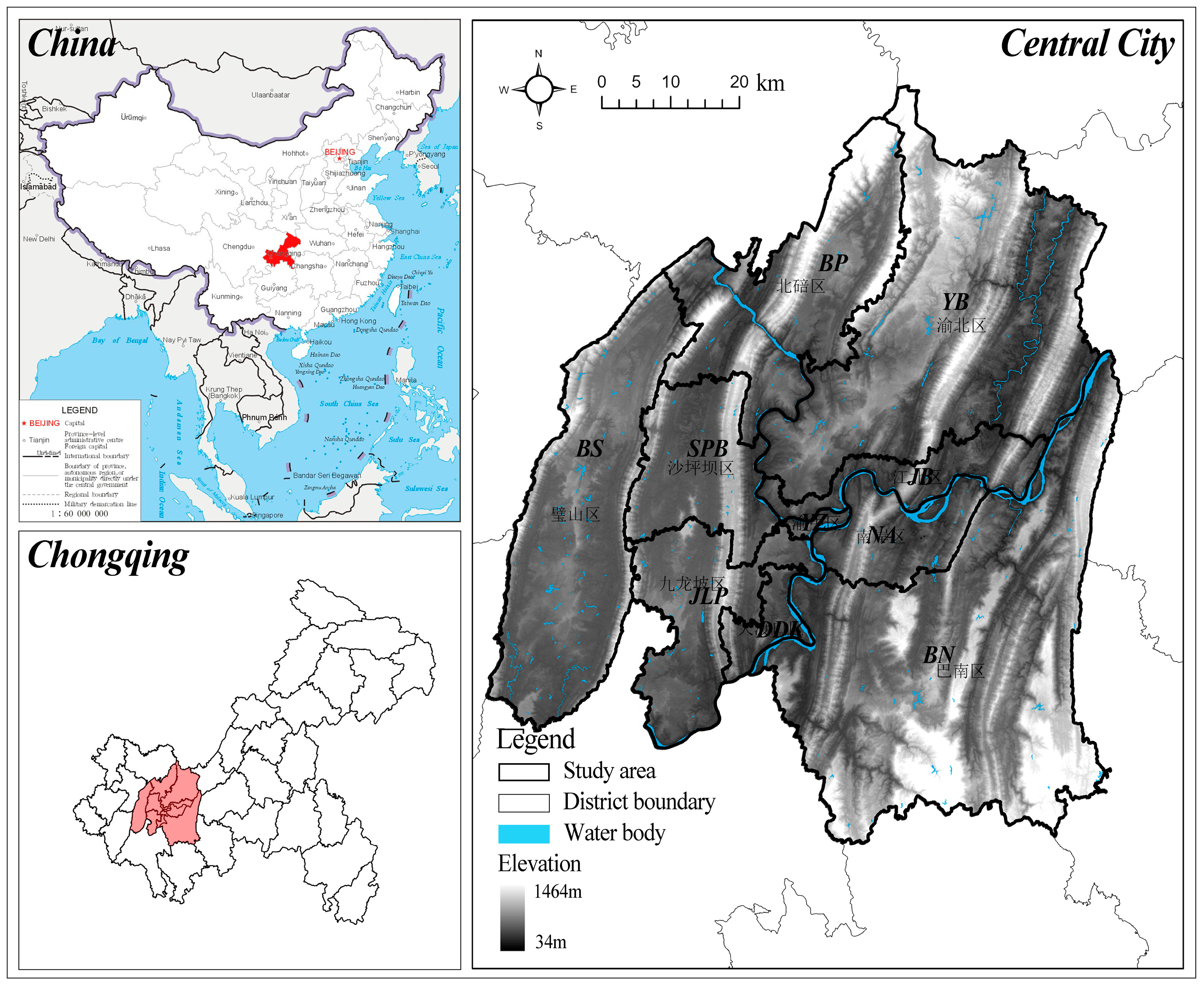
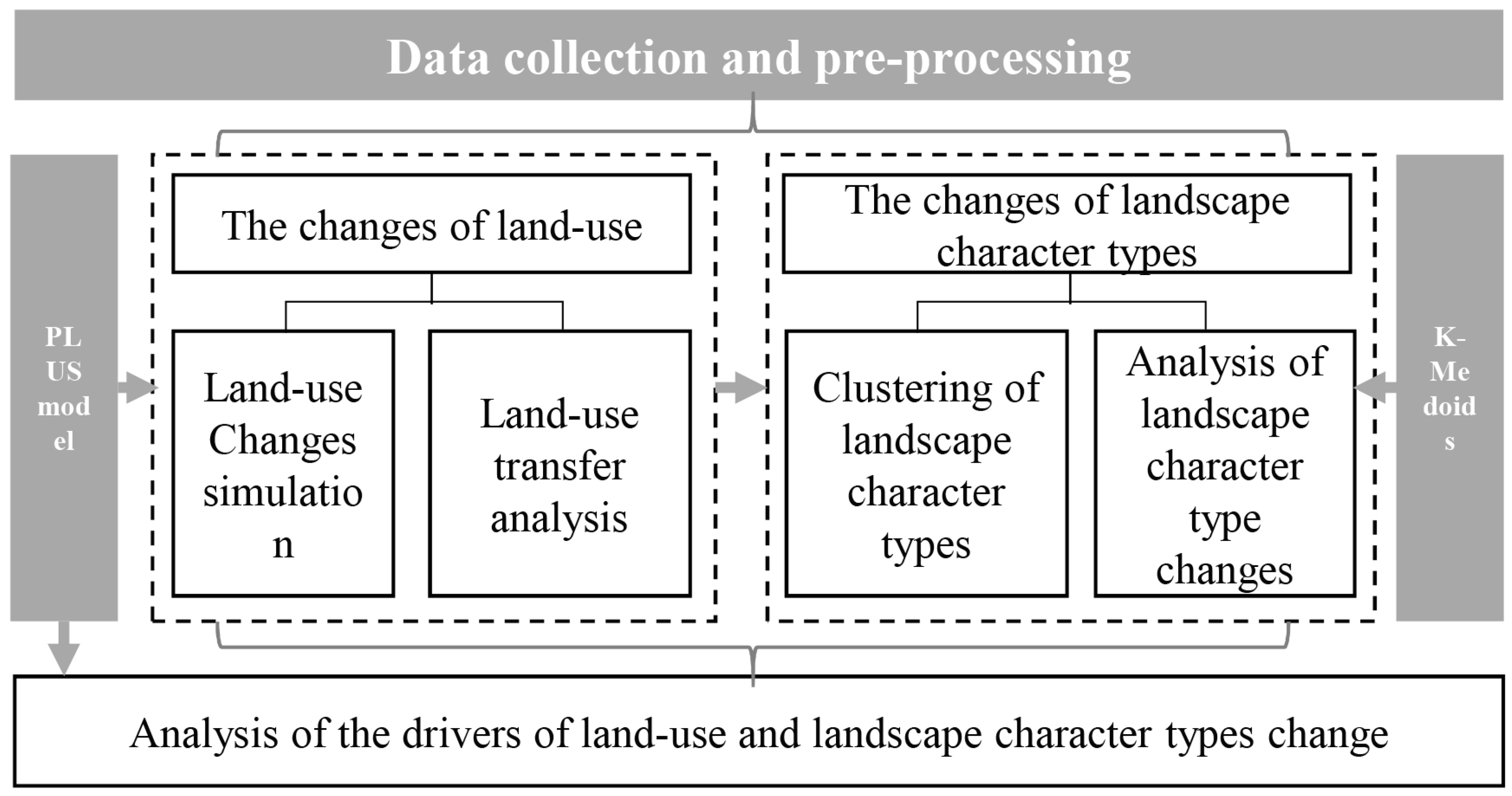
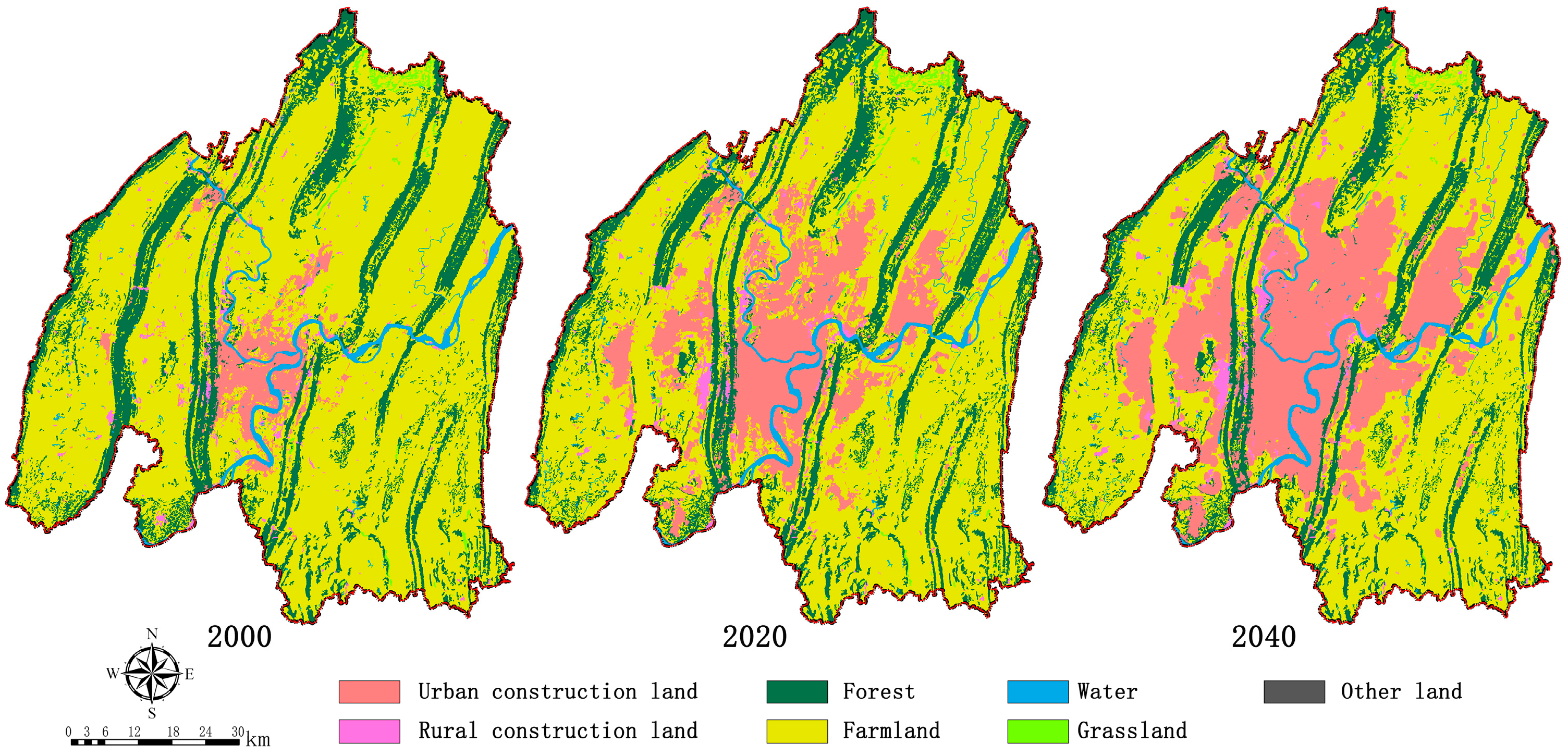
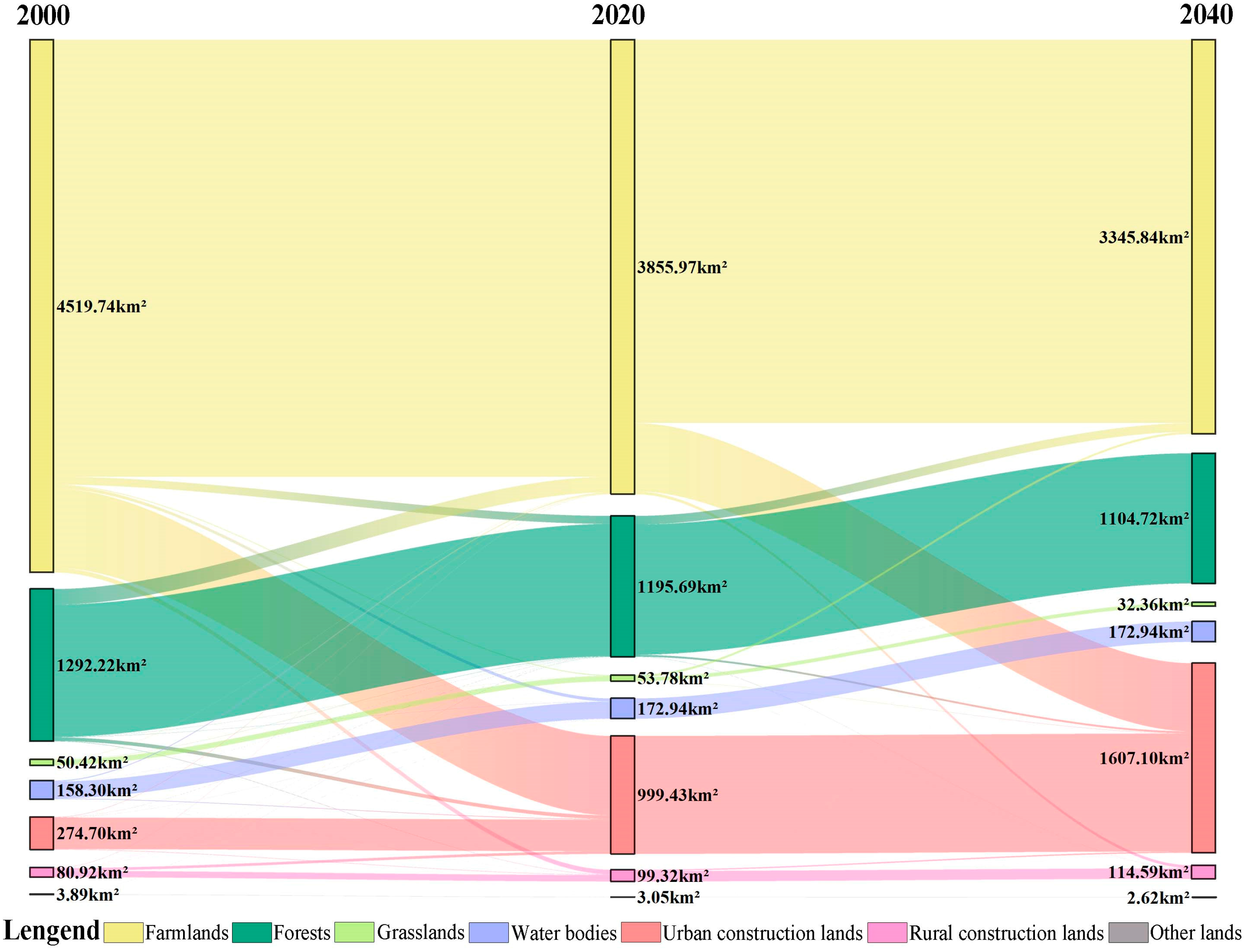
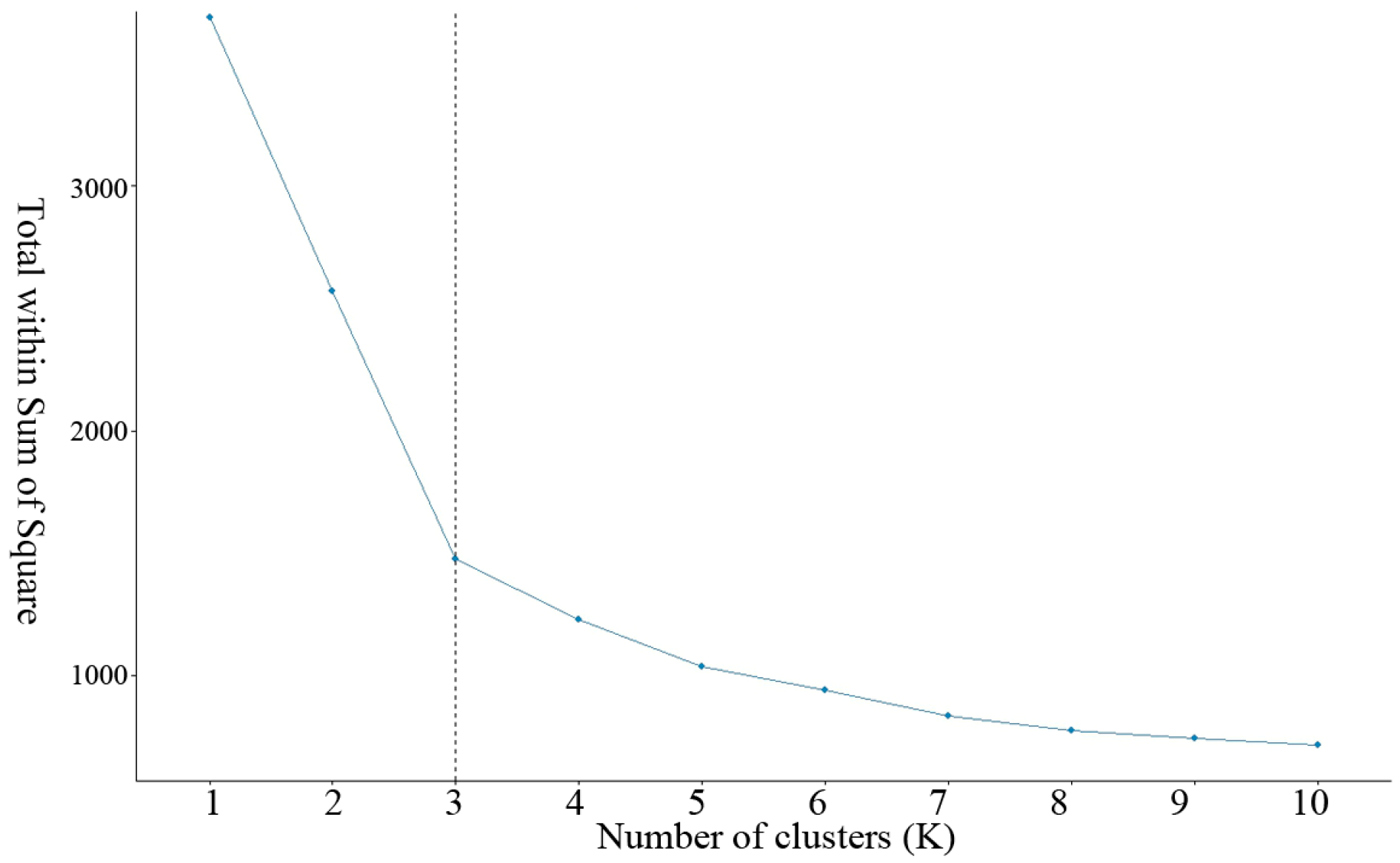
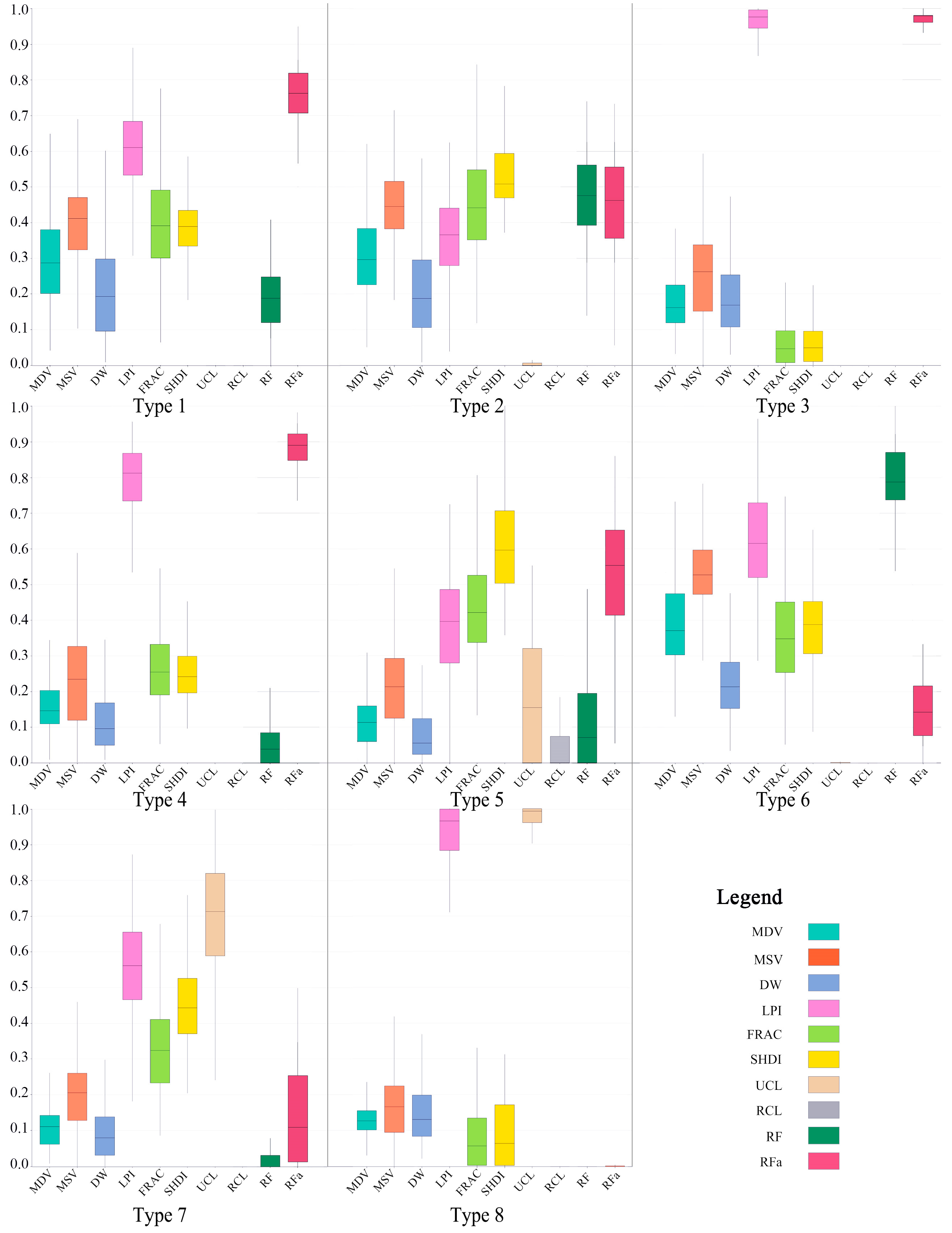
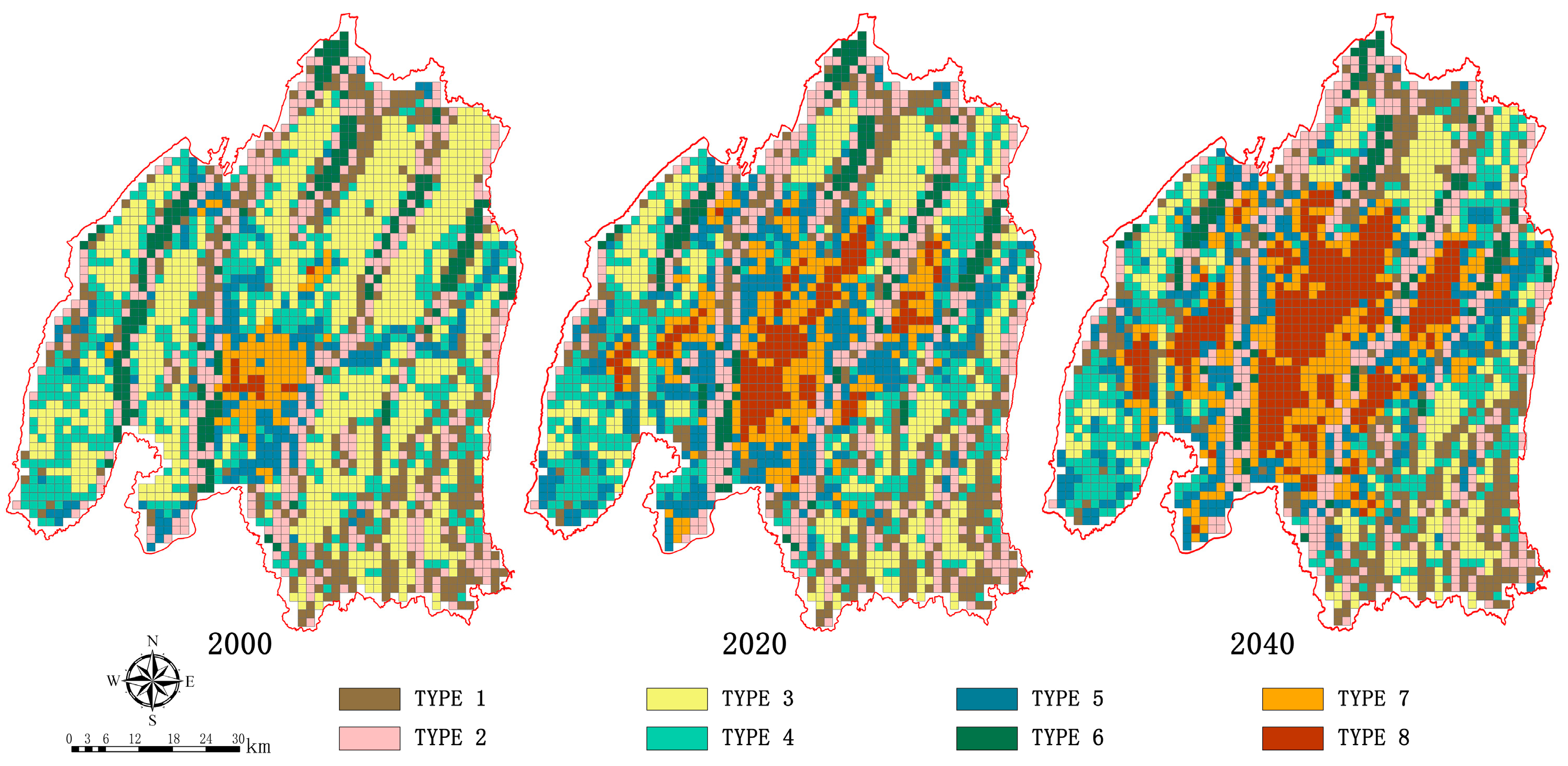
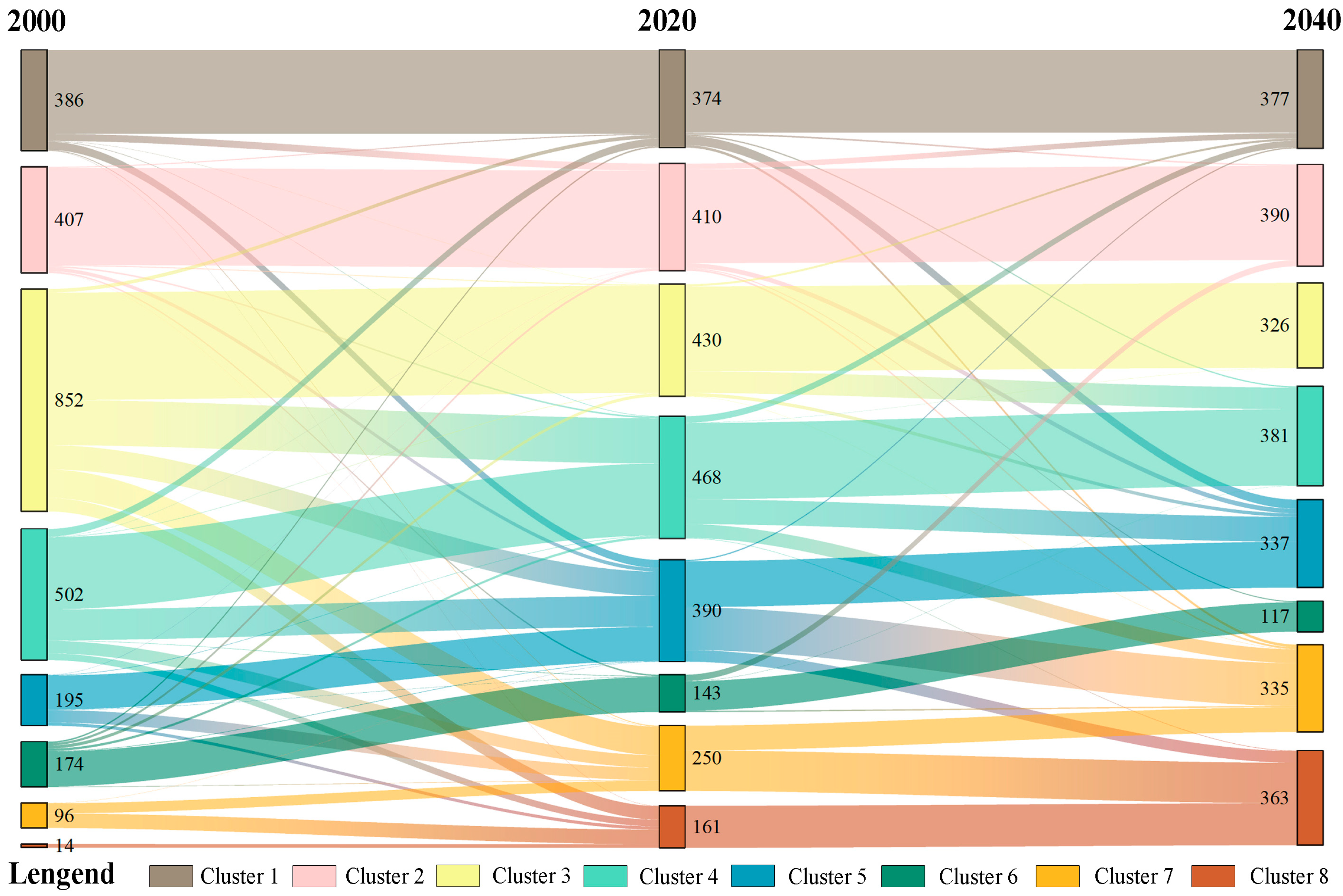
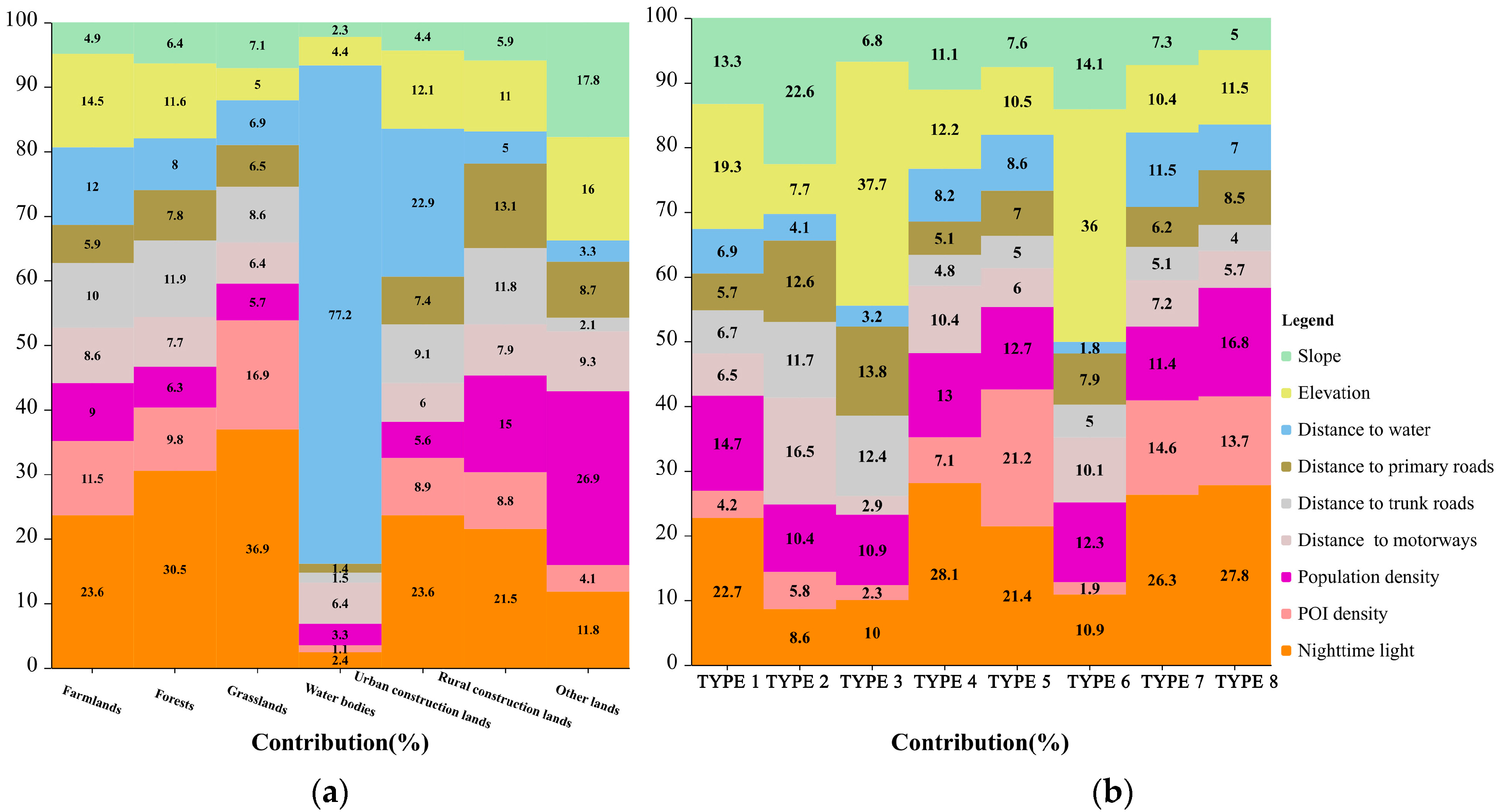
| Data | Source | Format | Year | Resolution |
|---|---|---|---|---|
| Land-use | www.dsac.cn, accessed on 8 February 2023. | Raster | 2000, 2020 | 30 × 30 m |
| DEM | www.gscloud.cn, accessed on 8 February 2023. | Raster | —— | 30 × 30 m |
| Transportation | openstreetmap.org, accessed on 8 February 2023. | Vector | 2020 | —— |
| Nighttime light | www.nature.com/articles/s41597-022-01322-5, accessed on 8 February 2023. | Raster | 2020 | 1 × 1 km |
| Population density | www.worldpop.org/, accessed on 8 February 2023. | Raster | 2020 | 30 × 30 arc (approximately 1 km at the equator) |
| Point of Interests | Baidu map | Vector | 2020 | —— |
| Land-Use Types | Farmlands | Forests | Grasslands | Water Bodies | Urban Construction Lands | Rural Construction Lands | Other Lands |
|---|---|---|---|---|---|---|---|
| Neighborhood weights | 0.15 | 0.1 | 0.01 | 0.03 | 0.45 | 0.25 | 0.01 |
| Dimension | Indexes | Explanation |
|---|---|---|
| Topography | Mean Elevation Value (MEV) | The mean elevation of each unit, used to describe whether it is in a plain, mountainous area, or a transitional zone. |
| Mean Slope Value (MSV) | The mean slope of each unit, used to describe whether its terrain is gentle or steep. | |
| Distance to Water bodies (DW) | The distance of each unit to the water, can reflect the spatial relationship between the samples and the rivers. | |
| Landscape pattern | Largest patch index (LPI) | To calculate whether there are dominant large patches within each unit, the formula is where n = number of patches in the landscape of patch type (class) i, j = area (m2) of patch ij, A = Total landscape area. |
| Area-weighted mean patch fractal dimension (AWMPED) | To calculate the complexity of patches shape within each unit. the formula is where m = number of patch types (classes) present in the landscape, n = number of patches in the landscape of patch type (class) i, = area (m2) of patch ij. | |
| Shannon’s diversity index (SHDI) | To evaluate the diversity of patches within each unit, = proportion of the landscape occupied by patch type (class) i. | |
| Land-use | Ratio of Urban Construction Land (RUL) | The proportion of urban and rural construction land, forests, and farmlands, which are the dominant land-use types in the study area. |
| Ratio of Rural Construction Land (RRL) | ||
| Ratio of Forests (RF) | ||
| Ratio of Farmlands (RFL) |
| 2020 (km²) | 2000 (km²) | ||||||||
| Land-Use Types | Farmlands | Forests | Grasslands | Water Bodies | Urban Construction Lands | Rural Construction Lands | Other Lands | Total (2020) | |
| Farmlands | 3707.18 | 132.82 | 2.16 | 8.20 | 2.94 | 2.50 | 0.16 | 3855.97 | |
| Forests | 67.68 | 1122.37 | 2.44 | 0.66 | 1.02 | 0.49 | 1.02 | 1195.69 | |
| Grasslands | 6.73 | 1.22 | 45.12 | 0.10 | 0.00 | 0.61 | 0.00 | 53.78 | |
| Water bodies | 26.27 | 1.65 | 0.33 | 143.12 | 0.83 | 0.58 | 0.15 | 172.94 | |
| Urban Construction lands | 673.10 | 31.24 | 0.35 | 5.54 | 266.52 | 22.64 | 0.03 | 999.43 | |
| Rural Construction lands | 38.59 | 2.90 | 0.02 | 0.38 | 3.34 | 54.09 | 0.00 | 99.32 | |
| Other lands | 0.18 | 0.01 | 0.00 | 0.30 | 0.04 | 0.00 | 2.52 | 3.05 | |
| Total (2000) | 4519.74 | 1292.22 | 50.42 | 158.30 | 274.70 | 80.92 | 3.89 | 6380.18 | |
| 2040 (km²) | 2020 (km²) | ||||||||
| Land-Use Types | Farmlands | Forests | Grasslands | Water Bodies | Urban Construction Lands | Rural Construction Lands | Other Lands | Total (2020) | |
| Farmlands | 3253.27 | 73.64 | 18.80 | 0.00 | 0.00 | 0.00 | 0.13 | 3345.84 | |
| Forests | 0.00 | 1104.23 | 0.45 | 0.00 | 0.00 | 0.00 | 0.04 | 1104.72 | |
| Grasslands | 0.00 | 0.30 | 32.06 | 0.00 | 0.00 | 0.00 | 0.00 | 32.36 | |
| Water bodies | 0.00 | 0.00 | 0.00 | 172.94 | 0.00 | 0.00 | 0.00 | 172.94 | |
| Urban Construction lands | 578.35 | 16.18 | 2.15 | 0.00 | 999.43 | 10.72 | 0.26 | 1607.10 | |
| Rural Construction lands | 24.35 | 1.33 | 0.31 | 0.00 | 0.00 | 88.60 | 0.00 | 114.59 | |
| Other lands | 0.00 | 0.00 | 0.00 | 0.00 | 0.00 | 0.00 | 2.62 | 2.62 | |
| Total (2020) | 3855.97 | 1195.69 | 53.78 | 172.94 | 999.43 | 99.32 | 3.05 | 6380.18 | |
| 2000 (%) | 2020 (The Proportion of Changes in Study Units %) | ||||||||
| Type | 1 | 2 | 3 | 4 | 5 | 6 | 7 | 8 | |
| 1 | 83.16 | 6.99 | 0.26 | 0.52 | 8.03 | 0.00 | 0.78 | 0.26 | |
| 2 | 0.98 | 91.40 | 0.98 | 1.47 | 3.44 | 1.47 | 0.25 | 0.00 | |
| 3 | 1.64 | 0.00 | 48.24 | 20.31 | 10.92 | 0.00 | 12.79 | 6.10 | |
| 4 | 5.78 | 0.20 | 0.40 | 54.98 | 23.51 | 0.40 | 9.56 | 5.18 | |
| 5 | 0.00 | 0.51 | 0.00 | 1.03 | 67.18 | 0.51 | 24.62 | 6.15 | |
| 6 | 3.45 | 5.17 | 6.90 | 5.17 | 1.15 | 77.01 | 1.15 | 0.00 | |
| 7 | 0.00 | 0.00 | 0.00 | 0.00 | 1.79 | 0.00 | 42.21 | 56.00 | |
| 8 | 0.00 | 0.00 | 0.00 | 0.00 | 0.00 | 0.00 | 0.00 | 100 | |
| 2020 (%) | 2040 (The Proportion of Changes in Study Units %) | ||||||||
| Type | 1 | 2 | 3 | 4 | 5 | 6 | 7 | 8 | |
| 1 | 85.03 | 1.60 | 0.00 | 1.34 | 9.36 | 0.00 | 2.67 | 0.00 | |
| 2 | 5.12 | 87.80 | 0.00 | 0.00 | 4.39 | 0.98 | 1.71 | 0.00 | |
| 3 | 1.86 | 0.00 | 75.58 | 19.30 | 3.02 | 0.00 | 0.23 | 0.00 | |
| 4 | 5.34 | 0.00 | 0.21 | 62.39 | 20.30 | 0.00 | 11.32 | 0.43 | |
| 5 | 1.28 | 0.00 | 0.00 | 0.00 | 45.13 | 0.00 | 42.05 | 11.54 | |
| 6 | 0.00 | 16.78 | 0.00 | 0.00 | 0.00 | 79.02 | 3.50 | 0.00 | |
| 7 | 0.00 | 0.00 | 0.00 | 0.00 | 0.00 | 0.00 | 38.00 | 62.00 | |
| 8 | 0.00 | 0.00 | 0.00 | 0.00 | 0.00 | 0.00 | 0.00 | 100 | |
Disclaimer/Publisher’s Note: The statements, opinions and data contained in all publications are solely those of the individual author(s) and contributor(s) and not of MDPI and/or the editor(s). MDPI and/or the editor(s) disclaim responsibility for any injury to people or property resulting from any ideas, methods, instructions or products referred to in the content. |
© 2023 by the authors. Licensee MDPI, Basel, Switzerland. This article is an open access article distributed under the terms and conditions of the Creative Commons Attribution (CC BY) license (https://creativecommons.org/licenses/by/4.0/).
Share and Cite
Mou, J.; Chen, Z.; Huang, J. Predicting Urban Expansion to Assess the Change of Landscape Character Types and Its Driving Factors in the Mountain City. Land 2023, 12, 928. https://doi.org/10.3390/land12040928
Mou J, Chen Z, Huang J. Predicting Urban Expansion to Assess the Change of Landscape Character Types and Its Driving Factors in the Mountain City. Land. 2023; 12(4):928. https://doi.org/10.3390/land12040928
Chicago/Turabian StyleMou, Jinsen, Zhaofang Chen, and Junda Huang. 2023. "Predicting Urban Expansion to Assess the Change of Landscape Character Types and Its Driving Factors in the Mountain City" Land 12, no. 4: 928. https://doi.org/10.3390/land12040928
APA StyleMou, J., Chen, Z., & Huang, J. (2023). Predicting Urban Expansion to Assess the Change of Landscape Character Types and Its Driving Factors in the Mountain City. Land, 12(4), 928. https://doi.org/10.3390/land12040928






